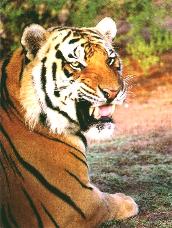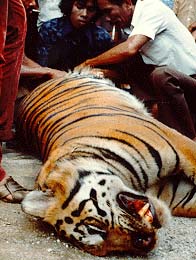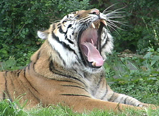

Tiger
Panthera tigris

It is said that no two Tigers have the same pattern of stripes, in the same way
that no two humans have the same fingerprints. Although a Tiger's stripes look
colorful and bold, they actually help the animal hide, because the stripes blend
in with the tall plants in its environment. There are several different races of
Tigers, ranging from the small Bali race to the Siberian, the largest cat in the
world. All Tigers are endangered and some of the races are likely extinct.
Look For: A very large, powerful wildcat with a striped coat. The coat varies
from whitish to yellow to orange or orange-brown, and the stripes range from
gray to brown to black.Related Species:
Length: Body 5-10' long, tail 24-36" long; 150-700 lb. Size varies greatly from
location to location.
Habitat: Forests and swamps, with dense ground vegetation.
Range: Asia; India, China, Indonesia, Mongolia, Siberia
TIGERS IN TROUBLE!
100 years ago there
were 8 different kinds of tigers (subspecies) - there were over 100,000 wild
tigers in the world. Today, there are only 5 tiger subspecies left and there are
fewer than 7,000 wild tigers in the world.
The
main threats to tigers are poaching, loss of habitat, and population
fragmentation.
 |
 |
 |
| FRIENDS OF THE EARTH | TIGER INFO CENTER | THREATS TO TIGERS |
![]()
![]()
 Welcome to the Tigers In Crisis Image Center
!
Welcome to the Tigers In Crisis Image Center
!
Many people have requested permission to use some of the beautiful images on
Tigers In Crisis of endangered tigers, so we decided to open the Tigers In
Crisis Image Center. Send a postcard and message to a friend, or download free
Tigers In Crisis images courtesy of Imagine Animals.com and ESBN(tm).
Created by: Sue Labbe